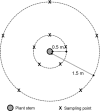Spatial variability of organic matter properties determines methane fluxes in a tropical forested peatland
- PMID: 30872875
- PMCID: PMC6383829
- DOI: 10.1007/s10533-018-0531-1
Spatial variability of organic matter properties determines methane fluxes in a tropical forested peatland
Abstract
Tropical peatland ecosystems are a significant component of the global carbon cycle and feature a range of distinct vegetation types, but the extent of links between contrasting plant species, peat biogeochemistry and greenhouse gas fluxes remains unclear. Here we assessed how vegetation affects small scale variation of tropical peatland carbon dynamics by quantifying in situ greenhouse gas emissions over 1 month using the closed chamber technique, and peat organic matter properties using Rock-Eval 6 pyrolysis within the rooting zones of canopy palms and broadleaved evergreen trees. Mean methane fluxes ranged from 0.56 to 1.2 mg m-2 h-1 and were significantly greater closer to plant stems. In addition, pH, ranging from 3.95 to 4.16, was significantly greater closer to stems. A three pool model of organic matter thermal stability (labile, intermediate and passive pools) indicated a large labile pool in surface peat (35-42%), with equivalent carbon stocks of 2236-3065 g m-2. Methane fluxes were driven by overall substrate availability rather than any specific carbon pool. No peat properties correlated with carbon dioxide fluxes, suggesting a significant role for root respiration, aerobic decomposition and/or methane oxidation. These results demonstrate how vegetation type and inputs, and peat organic matter properties are important determinants of small scale spatial variation of methane fluxes in tropical peatlands that are affected by climate and land use change.
Keywords: Carbon dioxide; Geochemistry; Methane; Organic matter; Rock-Eval pyrolysis; Tropical peat.
Figures







Similar articles
-
Plant root carbon inputs drive methane production in tropical peatlands.Sci Rep. 2025 Jan 25;15(1):3244. doi: 10.1038/s41598-025-87467-w. Sci Rep. 2025. PMID: 39863691 Free PMC article.
-
Evaluation of vegetation communities, water table, and peat composition as drivers of greenhouse gas emissions in lowland tropical peatlands.Sci Total Environ. 2019 Oct 20;688:1193-1204. doi: 10.1016/j.scitotenv.2019.06.366. Epub 2019 Jun 24. Sci Total Environ. 2019. PMID: 31726550
-
Carbon dioxide and methane fluxes in drained tropical peat before and after hydrological restoration.Ecology. 2008 Dec;89(12):3503-14. doi: 10.1890/07-2038.1. Ecology. 2008. PMID: 19137955
-
An appraisal of Indonesia's immense peat carbon stock using national peatland maps: uncertainties and potential losses from conversion.Carbon Balance Manag. 2017 Dec;12(1):12. doi: 10.1186/s13021-017-0080-2. Epub 2017 May 19. Carbon Balance Manag. 2017. PMID: 28527145 Free PMC article. Review.
-
Tropical peatlands and their contribution to the global carbon cycle and climate change.Glob Chang Biol. 2021 Feb;27(3):489-505. doi: 10.1111/gcb.15408. Epub 2020 Dec 4. Glob Chang Biol. 2021. PMID: 33070397 Review.
Cited by
-
Plant root carbon inputs drive methane production in tropical peatlands.Sci Rep. 2025 Jan 25;15(1):3244. doi: 10.1038/s41598-025-87467-w. Sci Rep. 2025. PMID: 39863691 Free PMC article.
-
Spatial and temporal variability of soil N2 O and CH4 fluxes along a degradation gradient in a palm swamp peat forest in the Peruvian Amazon.Glob Chang Biol. 2020 Dec;26(12):7198-7216. doi: 10.1111/gcb.15354. Epub 2020 Oct 9. Glob Chang Biol. 2020. PMID: 32949077 Free PMC article.
-
Impact of forest plantation on methane emissions from tropical peatland.Glob Chang Biol. 2020 Apr;26(4):2477-2495. doi: 10.1111/gcb.15019. Epub 2020 Feb 20. Glob Chang Biol. 2020. PMID: 31991028 Free PMC article.
-
Detecting tropical peatland degradation: Combining remote sensing and organic geochemistry.PLoS One. 2023 Mar 29;18(3):e0280187. doi: 10.1371/journal.pone.0280187. eCollection 2023. PLoS One. 2023. PMID: 36989287 Free PMC article.
References
-
- Albrecht R, Sebag D, Verrecchia E. Organic matter decomposition: bridging the gap between Rock-Eval pyrolysis and chemical characterization (CPMAS C-13 NMR) Biogeochemistry. 2015;122:101–111. doi: 10.1007/s10533-014-0033-8. - DOI
-
- Ayres E, Steltzer H, Simmons BL, Simpson RT, Steinweg JM, Wallenstein MD, Mellor N, Parton WJ, Moore JC, Wall DH. Home-field advantage accelerates leaf litter decomposition in forests. Soil Biol Biochem. 2009;41:606–610. doi: 10.1016/j.soilbio.2008.12.022. - DOI
-
- Barre P, Plante AF, Cecillon L, Lutfalla S, Baudin F, Bernard S, Christensen BT, Eglin T, Fernandez JM, Houot S, Katterer T, Le Guillou C, Macdonald A, Van Oort F, Chenu C. The energetic and chemical signatures of persistent soil organic matter. Biogeochemistry. 2016;130:1–12. doi: 10.1007/s10533-016-0246-0. - DOI
-
- Bauhus J, Bartsch N. Fine-root growth in beech (Fagus sylvatica) forest gaps. Can J For Res. 1996;26:2153–2159. doi: 10.1139/x26-244. - DOI
-
- Behar F, Beaumont V, De B. Penteado HL. Rock-Eval 6 technology: performances and developments. Oil Gas Sci Technol. 2001;56:111–134. doi: 10.2516/ogst:2001013. - DOI
LinkOut - more resources
Full Text Sources
Molecular Biology Databases
